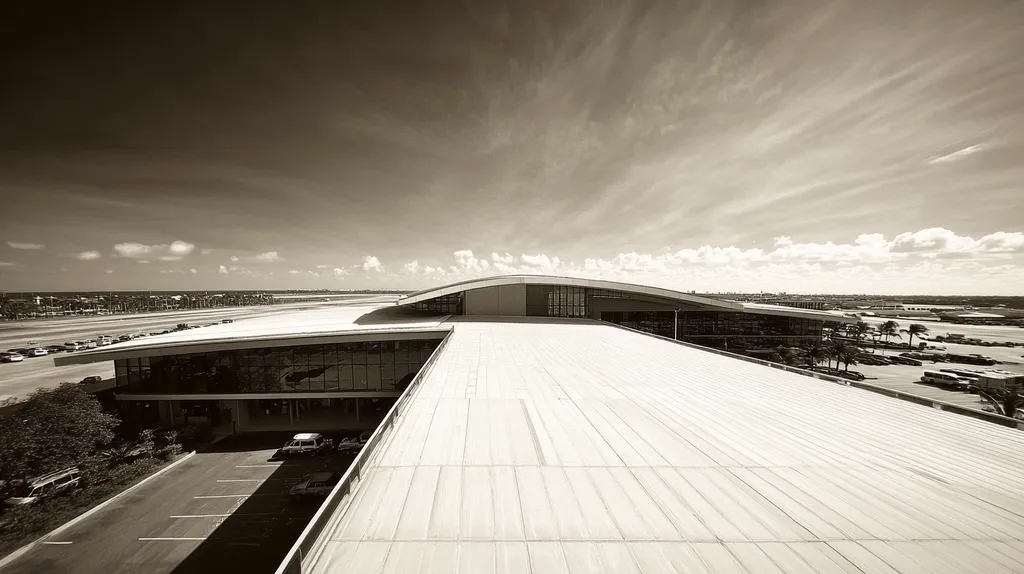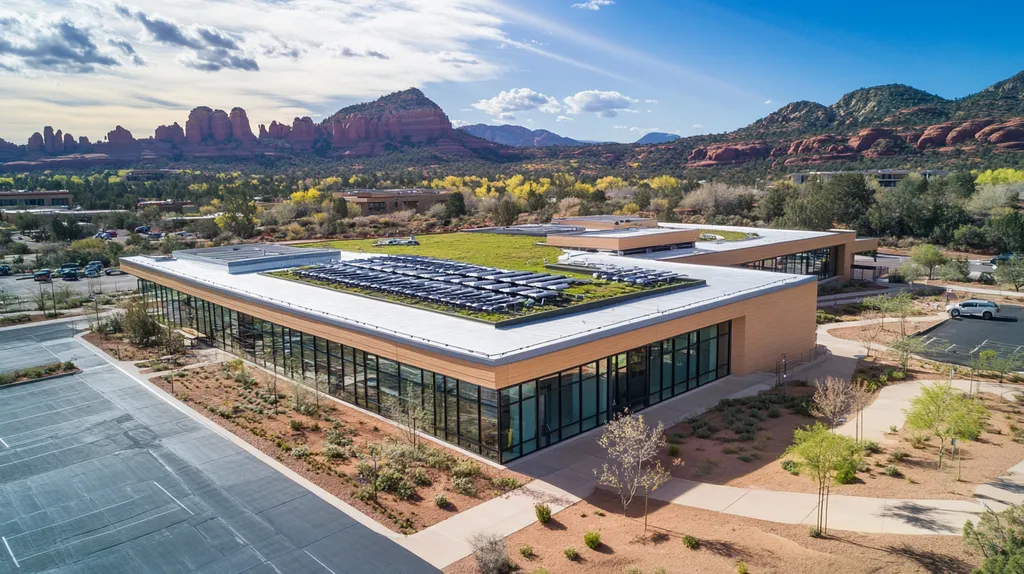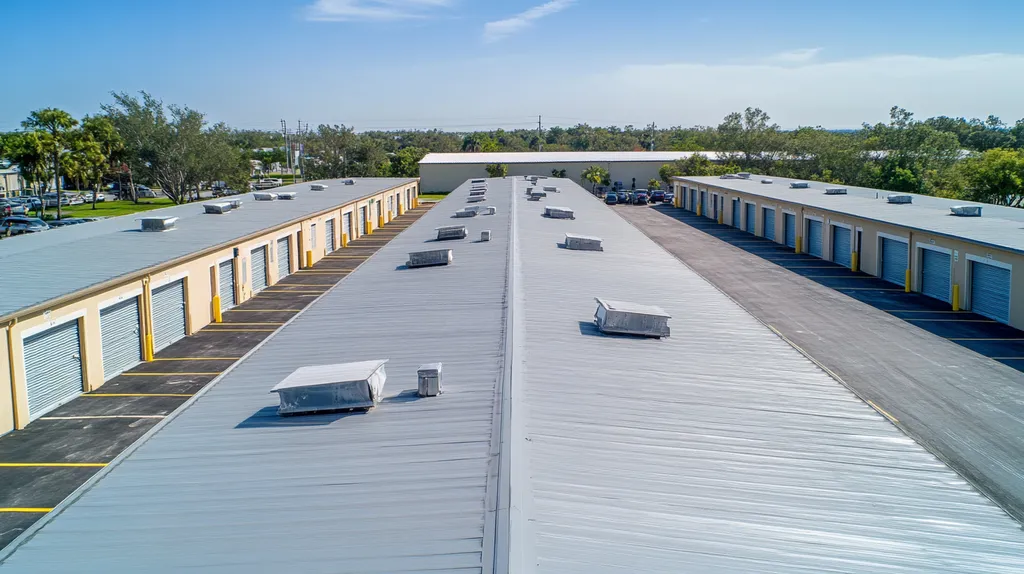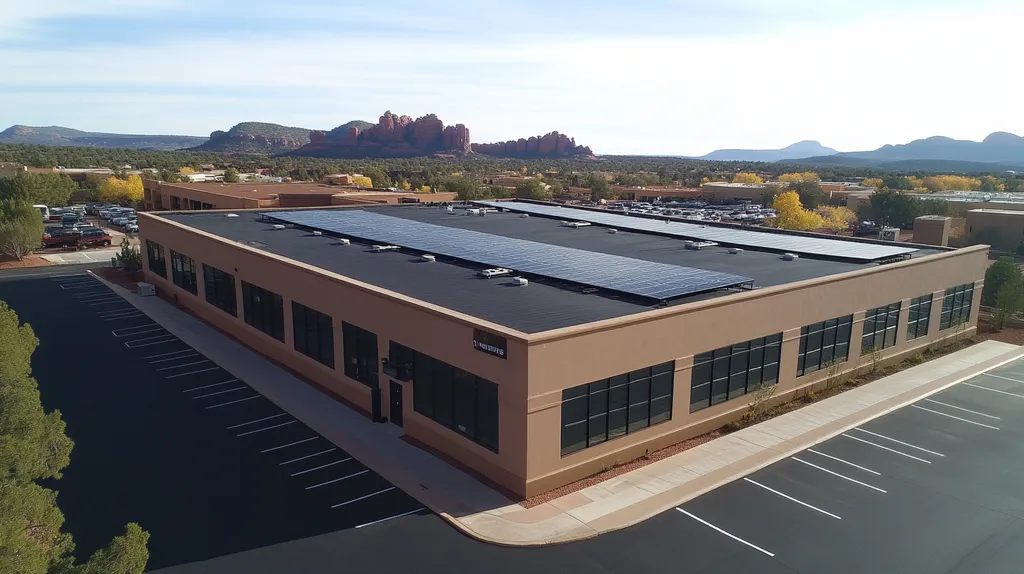In commercial roofing, age isn’t just a number—it’s a critical factor that demands increasingly sophisticated inspection approaches. With 40% of commercial roof failures traced to inadequate age-appropriate inspections, property owners can’t afford to ignore this evolution.
From basic visual checks on new installations to advanced thermal imaging for aging systems, inspection methods must adapt as roofs mature. The stakes are high: a missed diagnosis on an aging roof can lead to catastrophic failures costing upwards of $250,000 in repairs.
This guide cuts through the industry hype to deliver practical, age-specific inspection strategies that protect your investment without falling for unnecessary “innovations” that add more flash than function.
SECTION 1: THE BASICS EXPLAINED
Roof inspections are not just a checkbox on your property management list—they’re a necessity. With nearly 60% of commercial roofs requiring repairs or replacements during their lifespans, overlooking timely inspections can lead to financial pitfalls that many property owners can’t afford. The age of your roof shifts the inspection game entirely. In this section, we’ll unravel what roof inspections are, why they matter deeply, and how they function, equipping property owners with essential knowledge for effective roof care.
What It Is (In Plain Language)
A roof inspection is a deep dive into the health of a commercial roof, aimed at spotting potential issues before they turn into expensive headaches. This process includes checking materials, looking for leaks, and assessing the overall structural strength. The specifics can vary greatly based on the roof’s age and the materials it’s made of.
Older roofs often bring a host of wear and tear that newer roofs don’t face yet. These inspections aren’t just a quick glance; they can incorporate moisture tests and insulation evaluations to create a comprehensive picture. Identifying trouble spots early can mean the difference between a minor repair and a costly overhaul.
Plus, regular inspections are key to keeping warranties valid and meeting safety regulations. Property owners should view inspections not as isolated events but as a continuous need as roofs age. In essence, a roof inspection is a vital evaluation aimed at ensuring longevity and safety, crucial for preserving the value of any commercial property.
Why It Matters (To Your Building)
The age of a roof is a game-changer when it comes to its condition and what maintenance it requires. Older roofs are more vulnerable to damage, setting the stage for costly repairs if problems are left unchecked. For instance, that aging roof you’re ignoring could develop leaks, leading to water damage and mold—an explosive combination for your bottom line.
Proactive inspections can spot issues early, ultimately extending the life of a roof and saving money down the line. In contrast, ignoring signs of aging can snowball into significant property damage and financial losses that could have been easily avoided.
Recognizing the importance of roof inspections empowers property owners to make educated choices. This not only enhances tenant safety but also boosts energy efficiency—making a solid case for regular inspections as a savvy investment.
Understanding why inspections are crucial allows property owners to prioritize roofing maintenance as a critical element of effective facility management.
How It Works
Roof inspections follow a detailed approach tailored to the specific age and type of roof. Inspectors typically kick off with a visual assessment, searching for clear signs of damage or wear. However, depending on the roof’s age and materials, more advanced techniques might come into play.
For example, infrared scans can unveil hidden moisture that the naked eye can’t detect, a particularly vital step for older roofs. Additionally, taking core samples can analyze insulation and material integrity, highlighting potential issues that could lead to catastrophic failure.
Every component of the inspection process hinges on the roof’s age. Newer roofs may be evaluated using less invasive methods, while older roofs often necessitate a more thorough scrutiny due to their elevated risk of failure.
This personalized approach ensures that the various challenges presented by different roof types and their ages are effectively addressed. Understanding how this inspection process works is vital for property owners to safeguard their investments and ensure that their roofs perform optimally.
SECTION 2: PRACTICAL APPLICATIONS
Understanding how the age of a commercial roof impacts inspection methods is crucial for property owners and facility managers. Aging roofs introduce unique complications, which can lead to rising repair bills or structural chaos if overlooked. For instance, a roof older than 20 years demands entirely different inspection strategies than one fresh off the installation line. This section delves into common inspection techniques, optimal timing for checks, and how roofs interplay with other building systems.
Common Uses & Examples
Different roof ages call for customized inspection approaches. For roofs younger than 10 years, a simple visual inspection usually suffices, zeroing in on surface wear and immediate red flags. However, as roofs age from 10 to 20 years, more sophisticated methods kick in—like moisture scans and infrared thermography—to uncover hidden water issues that often arise from age-related deterioration.
Once roofs cross the 20-year threshold, comprehensive evaluations become non-negotiable. Techniques such as core sampling and intricate structural assessments are essential to determine how much damage has occurred. Identifying the extent of deterioration is critical for laying out effective maintenance or replacement plans. Inspection methods must align not only with the roof’s age but also with the specific materials and construction techniques used.
When You Need It Most
Timing is everything when it comes to roof inspections. The first check should occur roughly one year after installation to catch early problems. Following that, inspections should be scheduled every 2 to 5 years based on the roof’s age and condition. Notably, roofs over 15 years old may require annual inspections due to their increased susceptibility to wear and tear.
Beyond the regular schedule, inspections post-significant weather events—like storms or hail—are vital. Damage from such events can accelerate the decline of older roofs. A proactive mindset helps prevent small issues from spiraling into major, costly repairs.
Interactions With Other Systems
A commercial roof doesn’t operate in a vacuum; it’s intertwined with various building systems. For example, the roof’s drainage system has a direct impact on the efficiency of the HVAC system. When assessing older roofs, it’s crucial to inspect how drainage system blockages or debris can lead to water pooling, posing risks to the roof and the building’s interior.
Additionally, over time, the insulation beneath the roof membrane can lose its effectiveness, which negatively affects energy efficiency. Evaluating these interactions gives property managers the information needed to make informed decisions about insulation upgrades and necessary retrofits. Recognizing these connections enhances maintenance efforts, ensuring a safe and efficient building environment.
SECTION 3: KEY TERMINOLOGY DECODED
Grasping the terminology of commercial roofing is crucial for property owners and facility managers. Misunderstandings about roof conditions can lead to costly errors—nearly 30% of premature roof failures arise from inadequate inspections using outdated methods. This section will demystify essential terms and industry jargon, empowering stakeholders to make informed decisions about roof inspections that take age and condition into account.
Essential Terms Explained
The term “roofing membrane” refers to the waterproof barrier that shields a roof from water damage. Knowledge of the specific type of membrane—like TPO or EPDM—is critical, as it impacts inspection techniques significantly.
Another vital term is “flashing.” This material covers joints and potential leak points. If flashing shows signs of wear, it could signal deeper issues, making it a priority for inspection.
“Life expectancy” describes how long a roofing system is expected to last under optimal conditions. Different roofing materials boast varied life spans, and this knowledge can help schedule timely inspections.
Additionally, “ponding” refers to water accumulation on flat roofs. If left unaddressed, this condition can escalate, making routine inspections essential for detecting and resolving the issue early to prevent structural damage.
Industry Jargon Translated
Industry jargon can muddle key concepts in roof inspections. A “virtual inspection” involves remote assessments using drones or cameras. While this tech can boost efficiency, understanding its limits is crucial for accurate evaluations.
Terms like “deferred maintenance” signal neglected repairs that build up over time. It’s important for clients to recognize how these issues impact roof durability and inspection frequency, which could help avoid unexpected expenses.
“Thermal imaging” refers to using infrared technology to detect hidden leaks or moisture problems. This technique can significantly aid early detection, underscoring the importance of keeping pace with inspection methods.
Lastly, being familiar with the phrase “punch list” is essential; it enumerates tasks or repairs remaining after an inspection. Knowledge of this concept helps prioritize actions that enhance overall roof performance.
Measurement & Units Simplified
Accurate measurement and units are foundational in roofing inspections. For instance, “slope” is often expressed as a ratio—like 4:12—indicating the roof rises 4 inches for every 12 horizontal inches. Understanding slope is key to assessing drainage needs and potential pooling complications.
The term “R-value” quantifies thermal resistance, showing how well insulation resists heat flow. Higher R-values mean better insulation performance, which is crucial for energy-efficient designs.
Units such as square feet (sq ft) are critical for calculating roof area and material requirements. Precise measurements streamline the inspection process and inform repair or replacement cost assessments.
Lastly, “wind uplift” refers to the wind pressure that can impact roofing materials, measured in pounds per square foot (psf). This metric is vital for ensuring roofs are built to withstand regional weather challenges effectively.
SECTION 4: DECISION FACTORS
When it comes to commercial roofs, age is more than just a number; it’s a deciding factor that shapes inspection methods, costs, and overall durability. Property owners who ignore the ramifications of age-related inspections are playing a risky game, exposing themselves to unexpected expenses and potential roof disasters. Each decision, whether to inspect or not, carries financial weight and can dictate the lifespan of the roofing system. Grasping these decision factors is essential to ensuring roofs remain structurally sound and efficient.
Cost Considerations
Cost plays a leading role in the decisions property owners make regarding roof inspections. As roofs mature, they might need specialized assessments, driving up costs compared to standard evaluations. However, investing in the right inspection methods early on can be a money-saver, revealing issues while they’re still manageable.
For instance, catching leaks or spotting material degradation at an early stage can slash repair costs and prolong the roof’s life. On the flip side, ignoring an aging roof can lead to hefty financial burdens due to severe damage or structural failure. So, budgeting for the right inspection methods should be a top priority for property owners.
Moreover, inspection expenses can vary based on factors like the roof’s material and design. A flat roof, for example, may need more detailed scrutiny than a sloped roof. Recognizing these nuances allows property owners to make astute financial choices.
Lastly, while advanced inspection technologies, like thermal imaging or drones, might seem pricey, they can deliver significant savings over time. These innovative approaches often uncover hidden issues, reducing the chances of costly repairs and safeguarding the roof’s integrity.
Performance Trade-offs
As roofs age, performance trade-offs become increasingly pronounced, and savvy property owners need to pay attention. An older roof may struggle under stress or adverse weather, translating into more frequent inspections. Property owners must recognize the correlation between performance and inspection frequency if they want to avoid disaster.
For example, a flat roof that has seen better days might have drainage issues, leading to ponding water and necessitating more regular inspections. Ignoring this can set up property owners for costly long-term damage. Proactive investment in robust inspection methods is crucial for maintaining performance levels.
Additionally, older roofing materials often require tailored inspections to assess their resilience against environmental pressures. Property owners must weigh the cost of specialized inspections against the risks of performance failures. Missing the mark on these adaptations can result in costly damage and maintenance headaches.
Consequently, understanding performance implications is essential for effective roof management. Property owners should consistently evaluate whether their inspection strategies are keeping pace with the performance expectations of their aging roofs.
Lifespan & Durability Factors
The lifespan and durability of a commercial roof play critical roles in determining inspection frequency. As roofs age, their capacity to withstand wear and tear diminishes, calling for a more rigorous inspection routine. Property owners must factor in how age impacts durability while planning maintenance strategies.
For instance, a roof nearing the end of its lifecycle might display signs of wear, like cracks or blistering. These red flags demand more frequent inspections to address issues proactively. A little vigilance can significantly extend the roof’s lifespan.
Furthermore, different roofing types come with varying lifespans. For instance, while metal roofs may outlast asphalt ones, both types can encounter specific durability challenges as time marches on. Understanding these distinctions empowers property owners to align their inspection strategies with their roofing materials’ unique needs.
Ultimately, the durability of an aging roof serves as a crucial guide for inspection planning. Property owners should find the balance between the necessity for regular assessments and the potential rewards of extending their roofs’ lifespans through timely maintenance and repairs.
SECTION 5: COMMON CHALLENGES
When it comes to commercial roofing inspections, understanding the common challenges is not just useful—it’s essential. Aging roofs don’t just accumulate character; they often host lurking issues that can escalate quickly. For roofs over 20 years old, statistics reveal a heightened risk of leaks—leading to repairs that can hit hard on the wallet and potentially compromise the building’s structure. Property owners must stay sharp for warning signs and proactive measures to secure their investments.
Frequent Problems & Solutions
Aging commercial roofs frequently face problems like leaks, punctures, and membrane deterioration. Exposure to harsh weather takes its toll, making regular inspections non-negotiable. For example, that flat roof might just look like a pool party, but water pooling is a recipe for accelerated wear.
Early identification is crucial, and property owners should aim for inspections at least twice a year—or right after a significant weather event. Preventive maintenance, like resealing joints and replacing worn flashing, can extend a roof’s life and save money in the long run.
Moreover, leveraging technology like infrared scans can reveal moisture lurking beneath the surface that traditional inspection methods may miss. By nipping these issues in the bud, property owners can dodge the expensive repairs that come from neglect.
By recognizing these frequent challenges and tackling them head-on, property owners can significantly enhance the longevity and reliability of their roofs. Ignoring minor problems today could lead to major disasters tomorrow—don’t let that happen.
Warning Signs To Watch For
The symptoms of aging commercial roofs can be telling, and property owners need to pay attention. Cracked or curling shingles and gaps in seams are red flags, indicating underlying issues that require urgent attention.
Discoloration on ceilings or interior walls often signals water leaks, jeopardizing not just the roof, but the entire building’s integrity. To avoid excessive repair costs, routine monitoring of these warning signs is paramount.
Unusual noises, like popping or creaking, shouldn’t be dismissed—they could indicate structural problems. When these sounds appear, it’s time to call in professionals for a closer look. Swift action can bolster the building’s safety and health.
By staying vigilant, property owners can avoid the financial strain of extensive repairs and keep their roofing systems functioning at peak effectiveness.
Preventative Approaches
Preventative maintenance can be a game-changer for aging roofs. Conducting biannual inspections allows for early identification of potential issues before they escalate into major headaches. These inspections should scrutinize drainage systems and seals, which serve as the first line of defense against leaks.
A little investment in regular cleaning—think debris removal and ensuring drainage paths are clear—can go a long way in warding off wear and tear. Neglect can accelerate deterioration, significantly increasing repair bills. Establishing a routine maintenance plan is a proactive shield against future expenses.
Additionally, utilizing a qualified roofing contractor for assessments can offer invaluable insights into necessary repairs or upgrades. Their experience can unearth vulnerabilities and improve the roof’s resilience.
These proactive measures don’t just prevent issues; they foster a culture of care that significantly extends the life of the roofing system. By prioritizing maintenance, property owners can minimize disruptions and safeguard their investments effectively.
SECTION 6: NEXT STEPS & RESOURCES
Ignoring the age-related quirks of roof inspections isn’t just careless; it’s a recipe for disaster. Skimping on appropriate inspection methods increases the risk of costly repairs and could compromise your building’s safety. Alarmingly, more than 30% of commercial roofs encounter major issues due to improper age-based inspections. This section outlines crucial next steps and valuable resources to ensure your roofing systems remain secure and dependable.
Questions To Ask Providers
Property owners should take the initiative to grill roofing contractors about their inspection practices specifically tailored to the roof’s age. Ask questions like, “What specific techniques do you use for older roofs?” and “How often do you recommend inspections based on age?” These queries will reveal whether a provider truly understands the deterioration patterns that come with age.
Don’t forget to ask, “Can you provide documentation of previous inspections?” This helps assess the consistency of care and spot any lingering issues. Checking on warranties related to inspections can also protect your future investments.
Moreover, dig into the inspection team’s knowledge about older roof systems. A seasoned provider is more likely to detect the subtle signs of aging that could snowball into significant headaches if ignored.
Establishing these discussions ensures a shared understanding between property management goals and the roofing service’s capabilities, ultimately fostering a safer building environment.
Industry Standards & Guidelines
Getting familiar with industry standards can significantly boost the quality of roof inspections. Organizations like the National Roofing Contractors Association (NRCA) offer comprehensive guidelines on inspection protocols tailored to roof age. Following these recommendations helps ensure inspections are thorough and well-suited to the specific challenges posed by aging roofs.
ASTM International standards also provide best practices for evaluating roof conditions based on age. These documents detail the methods for assessing materials, structure, and potential points of failure.
Additionally, the Roof Consultants Institute publishes research on advanced inspection techniques—including infrared thermography and moisture surveys—specifically catered to older roofs at risk for hidden damage. Staying informed with these resources can elevate a property owner’s approach to roofing management.
Being knowledgeable about existing guidelines allows property managers to set higher expectations for inspection quality and ensure adherence to safety regulations.
Further Learning Simplified
To deepen understanding of age-related roof inspection methods, a wealth of resources is at your fingertips. Online webinars hosted by roofing experts cover various topics, from basic maintenance to advanced inspection technologies tailored for aging roofs.
Books and publications from trusted roofing associations serve as excellent educational tools. Look for titles that focus on the life cycle of roofing materials—these can provide critical insight into how age impacts inspection practices.
Engaging with local roofing trade shows or workshops offers hands-on experience and direct access to industry professionals. These events create networking opportunities that can lead to informed decisions about roofing service providers.
Embracing continuous learning about roofing best practices not only enhances initial inspection outcomes but also influences long-term building health, saving money and resources for property owners.
The Bottom Line
With 40% of commercial roof failures linked to inadequate age-based inspections, property owners can’t afford to ignore how inspection methods must evolve as roofs age.
The financial stakes are staggering—a single missed diagnosis on an aging roof can trigger $250,000 or more in emergency repairs and structural damage.
Smart property owners recognize that different life stages demand different inspection approaches, from basic visual checks on new installations to advanced thermal imaging for aging systems.
While flashy new “smart roof” technologies flood the market, the fundamentals remain unchanged: age-appropriate inspection methods, properly executed, are the cornerstone of protecting your roofing investment.
The choice is clear—adapt inspection methods to match your roof’s age or risk catastrophic failure when you least expect it.
FREQUENTLY ASKED QUESTIONS
Q. What is a commercial roof inspection?
A. A roof inspection examines the overall condition of a commercial roof. It includes checking for leaks, material integrity, and potential structural risks. This process varies with roof age, making it crucial for property management.
Q. How does the age of a commercial roof influence inspection?
A. As roofs age, they require different inspection techniques. Newer roofs might need simple visual checks, while aging roofs demand detailed assessments to uncover hidden problems that can escalate quickly.
Q. When should I schedule inspections for my industrial roof?
A. Inspect your industrial roof annually if it’s over 15 years old, and after significant weather events. Regular checks prevent minor issues from snowballing into costly repairs.
Q. What common issues affect aging commercial roofs?
A. Common issues include leaks, membrane deterioration, and punctures. As roofs age, these problems can lead to significant structural damage if not identified early, underscoring the need for frequent inspections.
Q. How can I choose the right inspection provider for my roof?
A. Ask providers about their techniques for aging roofs, inspection frequency, and previous work documentation. Experienced contractors will understand age-related challenges better, ensuring thorough inspections.
Q. What resources can help me maintain my commercial roof?
A. Refer to the National Roofing Contractors Association for guidelines on aging roof inspections. Additionally, attending workshops and webinars can deepen knowledge of maintenance best practices and emerging technologies.
Q. How do I know if my industrial roof needs immediate attention?
A. Look for signs like leaks, cracks, sagging, or unusual noises. Discoloration on ceilings can signal water infiltration, which demands prompt inspection to prevent costly damages over time.










